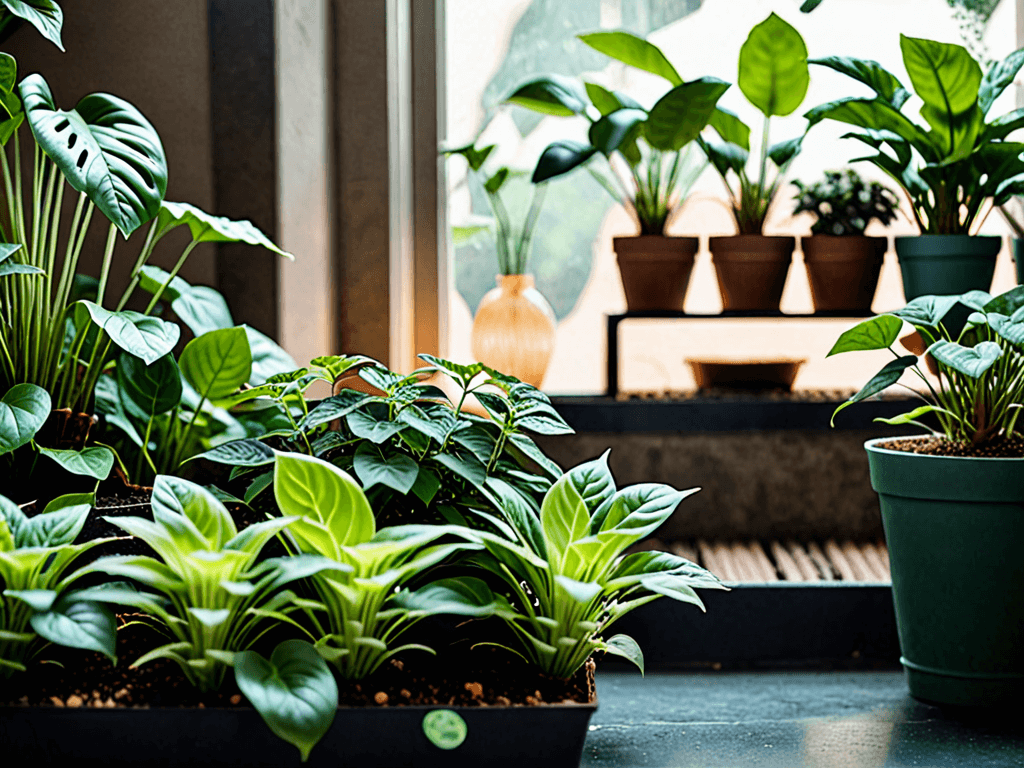Indoor gardening is transforming home spaces, bringing nature indoors and enhancing living areas.
By starting an indoor garden, you can enjoy fresh herbs, beautiful flowers, and lush greenery all year round.
Whether you’re a seasoned gardener or a novice, there are numerous techniques and tips to help you craft the perfect indoor garden.
Let’s dive into the essentials of indoor gardening and uncover the benefits, tools, and strategies to get started today.
Introduction to Indoor Gardening
Indoor gardening is a popular hobby that allows individuals to bring nature into their home. It involves growing plants, herbs, and flowers inside a living space, creating a natural, calming environment.
Indoor gardening can vary from simple houseplants to elaborate setups featuring hydroponics and grow lights. This approach makes it easier for plants to thrive without traditional outdoor conditions.
Understanding the basics helps ensure success, from selecting suitable plants to providing necessary light and nutrients.
Explore the world of indoor gardening to discover how it brightens up a home and improves air quality while providing a rewarding experience.
Benefits of Indoor Gardening
Indoor gardening offers numerous benefits for both mental and physical well-being. It helps purify the air by removing toxins and increasing humidity, providing cleaner and fresher air for occupants. Gardening indoors can also boost mood and productivity by creating a calming environment that alleviates stress and anxiety. Additionally, having access to fresh herbs and vegetables year-round enhances culinary experiences and promotes healthy eating habits. Indoor gardening offers a sense of accomplishment as plants thrive, making it a fulfilling hobby for all ages.
Essential Indoor Gardening Tools
Equipping yourself with the right indoor gardening tools is essential for a thriving garden.
Start with high-quality pots that provide adequate drainage, as well as adjustable plant stands for optimal light exposure.
A watering can with a narrow spout makes it easier to reach plants without overwatering.
Pruning shears are indispensable for trimming and maintaining plant health, ensuring vigorous growth.
Also, a soil moisture meter can help monitor hydration levels, preventing both under and over-watering.
Invest in a grow light for plants needing extra illumination, especially during darker months.
These essential tools make indoor gardening simpler and more effective, allowing plants to flourish indoors.
Choosing the Right Plants for Indoors
Selecting the right plants for indoor gardening is crucial for a successful setup. Consider your home’s light conditions; low-light plants like snake plants and pothos thrive in dim corners, while succulents and cacti need bright, sunny spots.
Evaluate available space, opting for compact plants if space is limited. Air plants and spider plants are excellent for hanging displays.
Keep in mind the care level; choose hardy plants like ZZ plants if you’re busy. Understanding each species’ needs ensures they flourish, contributing to a vibrant indoor environment that matches your lifestyle.
Caring for Indoor Plants
Caring for indoor plants involves ensuring they receive the right amount of water without overwatering, as excess moisture can lead to root rot.
Regularly check the soil moisture to determine when to water, typically when the top inch feels dry.
Fertilize during the growing season to provide essential nutrients, using a diluted, balanced liquid fertilizer.
Ensure adequate light based on the plant’s needs, supplementing with grow lights if necessary in darker environments.
Regularly clean leaves to prevent dust buildup and inspect for pests, treating promptly with organic insecticides if needed.
Rotate plants periodically to promote even growth and ensure they receive uniform light exposure.
Dealing with Common Indoor Plant Problems
Addressing common indoor plant problems can ensure your plants remain healthy.
Yellowing leaves often indicate overwatering, so check the soil’s drainage and adjust watering accordingly.
If leaves are browning, it might be due to low humidity or insufficient light, so consider increasing humidity or relocating the plant to a brighter spot.
Pests like aphids or spider mites can be controlled using natural remedies like neem oil or insecticidal soap.
Regular inspection and cleaning of plants can help catch these issues early.
Identifying symptoms properly allows for quick action to save and nurture plants back to health.
Decorative Ideas for Indoor Gardening
Enhancing your indoor garden with decorative ideas can transform your living space.
Consider using stylish planters made of ceramic or glass to add a touch of elegance.
Create visual interest by arranging plants at different heights using shelves or hanging baskets, which utilize vertical space efficiently.
Incorporate fairy lights around larger plants or on shelves to create a cozy ambiance in the evenings.
Utilizing mirrors behind plants can make spaces feel larger and reflect light, benefiting plant growth.
For a personalized touch, use themed pots or plant stands that complement your interior decor, making your indoor garden a seamless part of your home environment.
Sustainable Practices for Indoor Gardens
Embracing sustainable practices for indoor gardens is essential for reducing environmental impact.
Start by using organic, peat-free potting soil to preserve peat bogs, a vital resource for absorbing carbon dioxide.
Water conservation can be achieved through methods like reusing rainwater or setting up a drip irrigation system for efficient watering.
Opt for compostable pots or recyclable containers instead of plastic to minimize waste.
Integrating a composting system in your indoor garden recycles plant waste and enriches the soil naturally.
Lastly, choosing native or drought-tolerant plant species can reduce the need for excessive watering and maintenance, promoting a self-sustaining garden environment.
In Conclusion: Cultivating Your Indoor Garden
Indoor gardening presents an accessible opportunity to enhance your living environment while reaping the therapeutic benefits of nurturing plants.
From selecting the right plants to implementing sustainable practices, each step enriches both your home and lifestyle.
By integrating decorative elements and solving common plant problems, your indoor garden can flourish, providing a personal oasis year-round.
Remember, the joy of indoor gardening lies in experimentation and learning, ensuring that your green thumb continues to grow.
Adopting these methods not only beautifies your space but also contributes positively to your well-being and ecological footprint.
FAQ – Indoor Gardening
What are the best plants for low-light conditions?
Plants like snake plants, pothos, and ZZ plants can thrive in low-light areas.
How often should I water my indoor plants?
Water requirements vary, but most indoor plants need watering once the top inch of soil is dry.
What pest control methods are safe for indoor plants?
Neem oil or insecticidal soap are effective and safe methods for controlling indoor plant pests.
How can I increase humidity for my indoor plants?
Using a humidifier, placing a water tray with pebbles, or misting leaves can increase humidity.
Can indoor plants be moved outside during warmer months?
Yes, but gradually acclimate them to outdoor conditions to avoid shock.
What are sustainable practices in indoor gardening?
Using organic soil, recycling containers, and composting plant waste are great practices.


